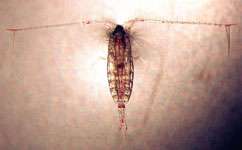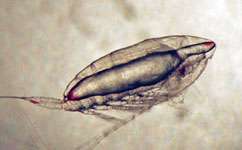Copepods eat their own weight belts

Scientists have solved the mystery of how tiny marine crustaceans called copepods regulate the rhythms of their life-cycle.
These minuscule animals form a vital link in the ocean food chain. They sit between phytoplankton, which turn sunlight into energy through photosynthesis, and the fish and other bigger creatures that many people rely on for food.
One of the most puzzling aspects of their behaviour is called the diapause. This is a little like mammals' ability to hibernate; in winter, copepods move down into deeper water and shut down many of their bodily functions, moving back to shallow waters only when warm weather returns and food becomes more plentiful.
The phenomenon goes on throughout the world's oceans, but until recently scientists haven't known much about how it works.
What sets it in motion? How can copepods control their buoyancy so as to stay in deep water throughout the winter without having to swim constantly to stay in place? And how do they know when it's time to come back up again? They're hundreds of metres deep, so they can't be sensing springtime's arrival directly.
It turns out that it's all about oil. The copepods have specialised fat stores that act like weight belts, letting the copepods maintain their depth easily and avoid attracting predators' attention with unnecessary movements. Building up enough fat reserves seems to be an essential step before diapause can begin - these reserves automatically trigger diapause once they reach a threshold level.
And because the fatty weight belts are also the energy stores that the copepods live off while in suspended animation, timing a return to the surface is simplicity itself - once they've eaten enough of the reserves, the oily liquids no longer weigh enough to keep them down, and they float back up to the surface.
'This is the final piece in the jigsaw puzzle of understanding diapause behaviour in copepods,' says Dr David Pond of the British Antarctic Survey, one of the authors of the paper, which was based on work by lead author Dr Katie Clark while she was studying for her PhD at the University of St Andrews.

'We can now see the whole thing as being controlled by the animals' fat reserves,' he adds. 'We used to think these reserves were like the petrol tank in a car - you just fill it up and off you go until it's empty. But now we're realising these animals are very selective about which kinds of fat they store, and which kinds they use.'
The researchers focused on the copepods of the species Calanus finmarchicus in Loch Etive on Scotland's west coast, sampling them throughout the year and analysing how much of various kinds of fat their bodies contained.
This population is unusual in that the loch is much shallower than the open-ocean habitats they're used to. This means that during diapause, they can't go nearly as deep - the loch's deepest point is 140m, whereas in the ocean copepods typically diapause below 500m.
The scientists found that these copepods burn up a huge chunk of their energy reserves during diapause.
Pond's earlier research had already shown that copepods use their fat reserves to control their buoyancy, so they can stay deep underwater without having to waste energy swimming.
This is possible because these oily liquids react to pressure by solidifying, which makes them denser. So when the copepods swim down to this critical depth, water pressure turns a proportion of their stored fat solid, weighing them down so no swimming is needed to stay in position.
This phase change happens around 500m beneath the surface, so the Loch Etive copepods never get deep enough to trigger it. This makes diapause an energy-intensive business, as they have to swim to stay deep.
This in turn means they burn stored energy quickly, eating through half their fat reserves during one diapause period. Pond says that in nearby open ocean, between 5 and 10 per cent is more a typical figure, so there's a definite cost to the animals of living in such shallow waters – although this may be partly counterbalanced by the fact the loch's waters are particularly rich in edible algae.
'The copepods can certainly thrive here, but their evolutionary stronghold - the habitat in which they're at the biggest advantage over other species - is the open ocean, and that's where the diapause gives the most benefits,' Pond says.
This latest paper completes the circle, showing that not only do fat reserves control buoyancy during diapause; they play a crucial role in both starting it and in bringing it to an end.
Pond explains that the unsaturated fats that are crucial for buoyancy control are found mostly in plankton algae known as diatoms, so having these to feed on is crucial for copepods' ability to diapause successfully. He now plans to look at whether similar mechanisms help control the movements of other animal plankton, such as krill.
The paper appears in the journal Limnology and Oceanography.
More information: Clark KAJ, Brierley AS, Pond DW. Composition of wax esters is linked to diapause behaviour of Calanus finmarchicus in a sea loch environment. Limnology and Oceanography. 57: 65-75.
Provided by PlanetEarth Online
This story is republished courtesy of Planet Earth online, a free, companion website to the award-winning magazine Planet Earth published and funded by the Natural Environment Research Council (NERC).


















